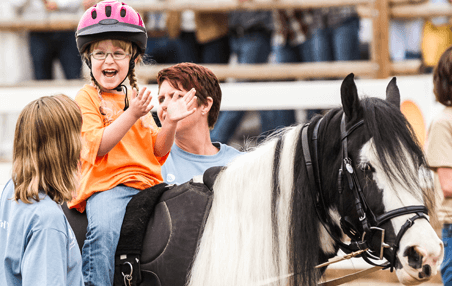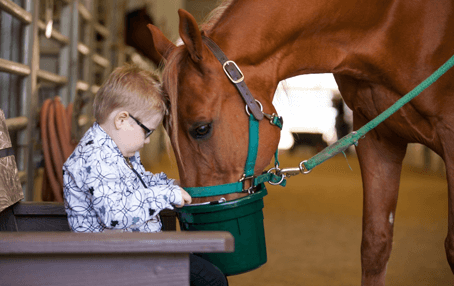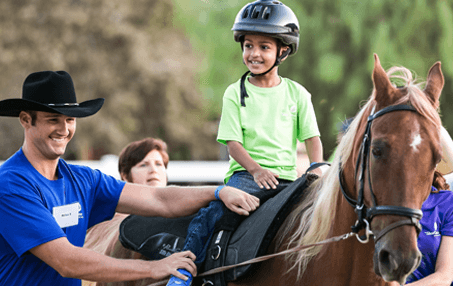EQUINE ASSISTED THERAPY
Equine Assisted Therapy (EAT) is physical, occupational, or speech therapy that may incorporate equine movement, non-mounted activities, and the equestrian environment.
Hippotherapy (HPOT) refers to how occupational therapy, physical therapy, and speech language pathology professionals use evidence-based practice and clinical reasoning in the purposeful manipulation of equine movement to engage sensory, neuromotor and cognitive systems to achieve functional outcomes. In conjunction with the affordances of the equine environment and other treatment strategies, hippotherapy is part of a patient’s integrated plan of care. Hippotherapy is derived from the Greek word “hippo,” meaning horse.
Why Use a Horse for Therapy?
Horses used in a therapy setting have received substantial specialized training in order to optimize the movement quality transmitted to the client. The movement of the horse is multi-dimensional and provides simulation of what a normal walking pattern should feel like. It is rhythmic, consistent, and predictable, like human walking. The repetitive movement allows the rider many opportunities to practice and refine balance responses, leading to improvements in core stabilization and postural control. The movement of the horse cannot be duplicated by any piece of equipment. The dynamic movement of the horse, combined with the dynamic environment, lead to functional change.Who Can Benefit from Hippotherapy as a Treatment Strategy?
By presentation: Impaired strength, range of motion, postural alignment, static and dynamic postural control, communication, sensorimotor function, mobility, coordination, or cognitive function.By diagnosis: Developmental delay, cerebral palsy, autism spectrum disorder, brain injury, sensory processing disorders, functional curvature of the spine, neuromuscular dysfunction, genetic syndromes, dyspraxia, or developmental coordination disorder.
These lists are a sample of impairments/diagnoses which may benefit, and are not all-inclusive. American Hippotherapy Association (AHA) Inc., © 2016.
Physical therapy treatments focus on developing balance by improving core stability to stay centered on the horse. Postural improvements occur as riders use their muscles to maintain an upright position on the moving surface. The movement of the horse influences movement of the pelvis and spine in a multi-dimensional pattern and positioning on the horse can help improve range of motion, strength, posture, and postural control. AHA Inc, © 2016.
Occupational therapy treatments focus on the movement of the horse and how it impacts the whole person, providing input that the therapist can alter to physical, sensory, cognitive, and emotional systems to address daily living skills. The horse is incorporated into treatment through using movement, ground activities, and relationships with the horse. AHA Inc, © 2016.
Speech/Language therapy patients’ neurological systems responsible for speech and language skills are impacted by the movement of the horse. Therapy focuses on:
- Improving arousal, rapidly gaining attentional focus, and motivation to participate
- Patient’s behavior difficulties are often managed positively by altering the horses movement
- Improving coordination, timing of sufficient respiratory support for quantity of treatment target per intervention
Often hippotherapy treatments allow for greater quantity of treatment target per intervention by reducing the amount of time a therapist spends gaining the patient’s attention and modifying behavior.
Related Links
Life Spirit Speech Pathology, Inc.
Speech therapy services are provided by Life Spirit Speech, an independent contractor of The Shea Center.
American Hippotherapy Association, Inc. (AHA)
Professional Association of Therapeutic Horsemanship International (PATH)
![]()


